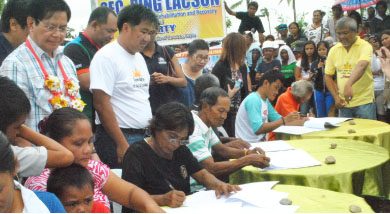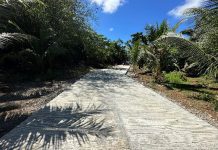
(LITO A. BAGUNAS)
TANAUAN, Leyte – Twenty families in this storm-stricken town are now in their permanent homes following the turnover of the first batch of housing units for Yolanda survivors last April 12, this year.
Presidential Assistant for Recovery and Rehabilitation Panfilo Lacson lauded the local government here and the Gawad Kalinga (GK) for their coordination in immediately building houses for survivors, who are either taking shelter in tents or temporary makeshift houses.
“The turnover ceremony will not be made possible without the indispensable participation of GK. With people like them, we are sure to rise from the rubble of destruction sooner than we can imagine,” Lacson said, addressing local officials and storm survivors in the new housing site in Pago village.
One of the first 20 homeowners, Arnie Penada, a 38-year-old fish vendor was moved to tears after receiving her new house with a floor area of 22 square meters (sqm). Each unit has a lot area of 36 sqm.
“Now, we can sleep well at night without worrying about big waves and strong winds every time there is a typhoon,” said Penada, whose old house in the so-called “no-build zone” in San Roque village was swept away by the giant waves generated by Yolanda on November 8,2013 .
The first 20 houses represent the first batch of the 366 housing units that will soon rise in Pago village, one the of three relocation sites identified by the local government.
“Our plan is to turnover houses to families in every two to three weeks,” said Tanauan Mayor Pelagio Tecson.
Each family is required to donate 1,500 hours of labor to fast track the construction phase. Recipients are obliged to complete the required working hours, even after the turnover of their houses.
About 500 residents are working on the site on a twice a week basis. The GK has deployed 500 volunteers to facilitate the rebuilding process.
This coastal town with a population of 53,310, is considered as pilot site for post-Yolanda rehabilitation and recovery among the 171 cities and municipalities in central Philippines pounded by the supertyphoon last year.
The permanent shelter for calamity victims is a joint project of the National Housing Authority, GK, Tanauan local government unit, and Department of Public Works and Highways.
Under the agreement, the NHA provided the funding for land development, prepared site engineering development plan, financed housing construction, and carry out survey works.
The local government unit assists GK in land acquisition, monitor project implementation, identify and screen project beneficiaries, and dispose housing units.
The DPWH is tasked to construct an access road to the housing site from the national highway and prepare engineering plans and cost estimates.
GK, on the other hand, has set aside a budget to acquire the land and donate it to the LGU for housing and counterpart budget for the construction of housing units. (SARWELL Q.MENIANO)



